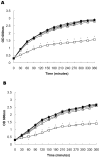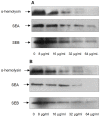Subinhibitory concentrations of thymol reduce enterotoxins A and B and alpha-hemolysin production in Staphylococcus aureus isolates
- PMID: 20305813
- PMCID: PMC2840024
- DOI: 10.1371/journal.pone.0009736
Subinhibitory concentrations of thymol reduce enterotoxins A and B and alpha-hemolysin production in Staphylococcus aureus isolates
Abstract
Background: Targeting bacterial virulence factors is now gaining interest as an alternative strategy to develop new types of anti-infective agents. It has been shown that thymol, when used at low concentrations, can inhibit the TSST-1 secretion in Staphylococcus aureus. However, there are no data on the effect of thymol on the production of other exotoxins (e.g., alpha-hemolysin and enterotoxins) by S. aureus.
Methodology/principal findings: Secretion of alpha-hemolysin, SEA and SEB in both methicillin-sensitive and methicillin-resistant S. aureus isolates cultured with graded subinhibitory concentrations of thymol was detected by immunoblot analysis. Hemolysin and tumor necrosis factor (TNF) release assays were performed to elucidate the biological relevance of changes in alpha-hemolysin, SEA and SEB secretion induced by thymol. In addition, the influence of thymol on the transcription of hla, sea, and seb (the genes encoding alpha-hemolysin, SEA and SEB, respectively) was analyzed by quantitative RT-PCR. Thymol inhibited transcription of hla, sea and seb in S. aureus, resulting in a reduction of alpha-hemolysin, SEA and SEB secretion and, thus, a reduction in hemolytic and TNF-inducing activities.
Conclusions/significance: Subinhibitory concentrations of thymol decreased the production of alpha-hemolysin, SEA and SEB in both MSSA and MRSA in a dose-dependent manner. These data suggest that thymol may be useful for the treatment of S. aureus infections when used in combination with beta-lactams and glycopeptide antibiotics, which induce expression of alpha-hemolysin and enterotoxins at subinhibitory concentrations. Furthermore, the structure of thymol may potentially be used as a basic structure for development of drugs aimed against these bacterial virulence factors.
Conflict of interest statement
Figures




References
-
- Lowy FD. Staphylococcus aureus infections. N Engl J Med. 1998;339:520–532. - PubMed
-
- Yoh K, Kobayashi M, Yamaguchi N, Hirayama K, Ishizu T, et al. Cytokines and T-cell responses in superantigen-related glomerulonephritis following methicillin-resistant Staphylococcus aureus infection. Nephrol Dial Transplant. 2000;15:1170–1174. - PubMed
Publication types
MeSH terms
Substances
LinkOut - more resources
Full Text Sources
Research Materials

